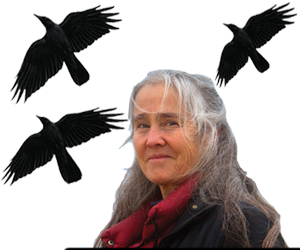 To the uninitiated, the birds all look the same — shimmering black feathers, with eyes, beaks and feet to match. They sound the same, too, their calls collapsing into cacophony as they rise and fall on the wing.
To the uninitiated, the birds all look the same — shimmering black feathers, with eyes, beaks and feet to match. They sound the same, too, their calls collapsing into cacophony as they rise and fall on the wing.
Not so for behavioral ecologist Anne Clark. Binoculars at the ready, the Binghamton University associate professor of biological sciences sees enough intrigue and drama among a murder of crows to one day fill a novel. There is the peanut hound abandoning her nest for a treat, the devoted father driven from home in his dotage — by his sons — and the orphaned juveniles insinuating themselves into a new family. Hear the alarm call? The territorial declaration?
Clark has devoted the past decade of her research career to deciphering the biological and social relationships among a population of some 2,000 American crows in Ithaca, N.Y. “I’m interested in social behavior,” she explains, “and these birds are not only long-lived, they have a very complex social life.”
Corvus brachyrhynchos, she says, rivals even the primates to whom behavioral ecologists have traditionally turned for insights into the evolutionary underpinnings of social relationships. The ubiquitous black birds mate for life, can survive for nearly two decades in the wild and collaborate in extended family groups to rear their young. The species toggles — sometimes hourly — between strict territoriality and peaceful social groupings that can number in the tens of thousands. The combination of communication skills, memory and cognitive sophistication that makes it all possible has yielded rich fodder for Clark, collaborator Kevin McGowan of Cornell University and more than a dozen Binghamton University graduate students.[iframe width=”560″ height=”315″ src=”http://www.youtube.com/embed/UDt2qmpCaGo” frameborder=”0″ allowfullscreen align=”right” style=”padding:7px”]
“I’m interested in complex groups that aren’t about predation or being together all the time,” says Clark, “and how individuals might follow different trajectories, navigating relationships over their lifespan.”
Complementary questions motivated McGowan back in 1990, when he began tagging and banding crows at Cornell’s Laboratory of Ornithology. The two started working together eight years later, when a student of Clark’s did some research with McGowan. These days, his post affords less time for the crows; Clark and her graduate students have filled the breach, expanding and extending the project. “I used to be in the field every day, March through June,” says the ornithologist. “I still do a lot of banding, but Anne keeps things going, keeps track of the data. Now it’s a community project.”
-By Sharon Tregaskis
Read the entire story: http://www.binghamton.edu/magazine/index.php/magazine/cover-story/in-the-company-of-crows

